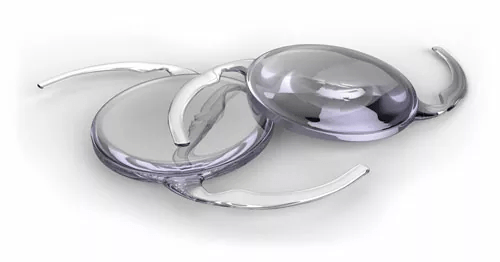What to Expect After Refractive Lens Exchange (RLE)
Sub Title

A lens implant can help individuals who are nearsighted or farsighted, who are having increased difficulty focusing on close objects (presbyopia), or who have cataracts beginning to form. An alternative to LASIK, refractive lens exchange (RLE) can reduce or eliminate the need for glasses or contact lenses. It is a 15-minute procedure that involves implanting a plastic intraocular lens (IOL) in place of the patient’s natural lens. The different types of IOLs include:
- Multifocal IOLs: Have built-in bifocal correction, providing clear distance vision when the eye looks directly ahead, while also enabling clarity of nearby objects.
- Monovision IOLs: Improve distance vision in the dominant eye. Left slightly under-corrected, the non-dominant eye retains a patient’s near vision.
- Accommodation IOLs: The new lens moves forward and backward as intraocular muscles flex. The focal point is changed naturally, often eliminating the need for bifocals or reading glasses.
What to Expect the Day of Surgery
RLE eye surgery is an outpatient procedure. Anesthetic drops numb the eye and the surrounding skin is cleaned. Sterile coverings are then placed around your eye, and an eyelid holder is placed to hold your eye open. While looking into an operating microscope, the surgeon creates a small incision, while ultrasound is used to fragment and remove the natural lens. The plastic intraocular lens is then inserted, after which the doctor closes the incision and places a protective shield over your eye.
What to Expect During Recovery
You are not sedated during surgery, and it is not painful. You’ll go home soon after, while immediate vision improvements are usually noticeable. However, you won’t be able to drive home that day. Most of the time, patients can resume driving and other normal activities within a week after having RLE surgery.
It may take several weeks to experience complete vision correction. During this time, you may experience blurred vision, glare, and halos, as well as mild discomfort. In addition to quick recovery, RLE doesn’t change corneal thickness, like laser surgery does and which can lead to possible complications, and you won’t need cataract surgery in the future. The corrective effects are permanent, even following age-related vision changes.
Is RLE Eye Surgery Right for You?
To be a candidate for RLE, you must be at least 21 and have had no significant vision changes in the past six months. You must also have no history of eye disease. The procedure is best suited to patients over the age of 40. It is preferred over LASIK for treating severe refractive errors and for patients with corneal abnormalities. While RLE can correct just about any degree of hyperopia (farsightedness), for people with myopia (nearsightedness) there is a risk of retinal detachment during surgery.
Schedule RLE Surgery at DLV Vision Centers
We specialize in refractive lens exchange surgery for patients with a range of vision problems. Our facilities are located in Westlake Village, Beverly Hills, Camarillo, San Luis Obispo, Encino, and Simi Valley, and we are equipped to provide effective cataract and refractive surgery. To schedule a complimentary consultation to see if RLE or other surgical option is right for you, call 805-953-7052 today.


